Introduction
Heat energy security is one of the most important issues in political praxeology, not only in Poland, but also in other European and world countries. One of the major current challenges is coming up with a strategy to combat heat energy poverty. It turns out that in 2019, 7.3% of households in the European Union declared that they could not afford sufficient heating of a house or apartment (Blisko, 2019; Dagoumas, 2014; Chukwuka, Monyei et al., 2019). In Poland, which until recently was ranked high among the countries affected most by heat energy poverty, the situation has improved significantly over the last ten years. The number of households having difficulties heating their apartments has dropped from 28.4% to 5.1%, which is more than a five-fold reduction, thus exceeding the European mean value. Achieving this was possible due to the effective policy not only at the government level, but also at the local level (by local government units). However, despite these undeniable achievements, some serious challenges remain in the area of effective heat energy security management.
The objective of the author of this paper is to show how, at present, the phenomenon of heat energy poverty is manifested, what are its origins and consequences, and what actions are being taken at the local level by local government units regarding the management of heat energy security in order to eliminate the problem of heat energy poverty in households by using geothermal energy, with particular emphasis on the difficulties and challenges related to this process.
Heat energy poverty and local energy security – an attempt at explaining the concepts on the basis of international literature
Heat energy poverty, which is part of the so-called fuel poverty or energy poverty, in other terms, is a phenomenon that is currently experienced by many households not only in Poland, but also in many countries of the European Union and around the world. Within the European Union, the problem of energy poverty affects over 7% of its inhabitants, especially in the countries of Central and Eastern Europe, as well as Southern Europe (Fan and Fang, 2020; Dagoumas, 2014; Horta, Gouveia, Schmidt, Sousa, Palma and Simoes, 2019; Sánchez-Guevara Sánchez, Mavrogianni and Neila González, 2017; Gouveia, Palma and Simoes, 2019).
In Poland, this phenomenon affects approximately 5.1% of households, especially in large voivodeships with more single-family houses, and in less developed voivodeships as well, so it is very diversified (Świerszcz and Grenda, 2018a; Gawlik-Kobylińska, 2017). The scale of the experienced energy poverty shows that this phenomenon is not something entirely new. Nevertheless, it has only recently begun to be examined as a separate problem, particularly the problem of heat energy poverty. It should be noted that such a term is not present in the Polish law or in the national public policy, and neither is it explicitly referred to as such in both domestic and foreign literature on the subject. Nonetheless, some aspects referring to it can be found in literature, especially by researchers dealing with the problem of energy poverty, the conceptual scope of which is broader, as it also includes electricity.
In the Polish literature on the subject, what is interesting is the definition proposed by D. Owczarek and A. Miazga, which includes aspects related to heat energy poverty, particularly visible when household dwellers experience two-fold difficulties in terms of energy needs. The first one is the problem of maintaining a certain level of heat that allows the adequate fulfillment of basic needs related to the biological and social functioning of the household dwellers. The adopted standard of heat in Polish apartments that provides a sense of comfort is the temperature of 21°C, while for other occupied rooms, it is 18°C (Owczarek and Miazga, 2015; Świerszcz, 2017a; Yoon and Sauri, 2019). The second difficulty consists in purchasing heat energy at a reasonable price in the place of one’s residence (Szpor, 2016; Cipriano, Gamboa et al. 2017; Muringathuparambil, Musango et al., 2017). The issue of heat energy poverty and an attempt at explaining its definition, in terms of energy poverty, can also be found in government documents, such as the “Draft of Poland’s Energy Policy until 2050”, which defines this phenomenon as a situation in which households are exposed to a reduction in energy consumption to a level absolutely necessary for their daily functioning (Projekt, 2014; Rodrigues, Gillott et al., 2020; Szyłkowska, 2019a).
In foreign literature on the subject, those who initiated a scientific approach to the phenomenon of heat energy poverty in terms of energy poverty were British researchers. B. Boardman, based on the experience and the nature of the phenomenon in his country, defines that energy poverty occurs when households have to spend more than 10% of their income on: heating the apartment, heating water, cooking, lighting and using electrical appliances. The expenses mentioned concern all types of energy, including heat energy, and they vary depending on the type of house or apartment (Boardman, 2012; Ucala & Xydis, 2020; Della Valle, 2019; Gouveia, Palma and Simoes, 2019). By defining the phenomenon in this way, the author draws attention to two issues: the hypothetical expenses for energy and a threshold of 10% of the total income of the household. It should be noted that for a long time, this definition was the basis for shaping public policies not only in Great Britain, but also in other countries affected by the problem of heat energy poverty. The definition above is complemented by another one, known as Low Income High Costs (LIHC), developed in Great Britain, in mid-2013. This definition uses two criteria to define the situation of heat energy poverty: low income of households and high energy costs (Fuel, 2013; Monyei, Oyedele et al., 2019; Bakirtas and Gokce Akpolat, 2018; Wojnarowska-Szpucha, 2020b). It should be emphasized that until recently, this was the only formally adopted and preferred definition of energy poverty. Hence, the majority of previously conducted research and statistics were, and still are, based on it.
A review of the Polish and foreign literature on the subject encourages an attempt at defining the concept of heat energy poverty in households. The phenomenon can be described as a situation when a household is experiencing difficulties in satisfying the basic needs of heat energy in an integral way and over a longer period of time, affecting the condition and level of life of its dwellers – both in a qualitative sense (the poor technical condition of residential buildings and heating systems, low energy efficiency, and improper use of heat energy), as well as in energy prices, being inaccessible to household dwellers, which results in difficulties in adapting to the requirements and standards in terms of heat energy, and consequently causes social exclusion (Świerszcz, 2019; Świerszcz, Grenda, Szczurek and Chen, 2019 ).
The analysis of heat energy poverty in households also requires the answer to the question: What is energy security in local terms, in the context of the researched phenomenon? In the government document “Poland’s Energy Policy until 2030”, energy security is understood as the state in which stable fuel and energy supplies can be ensured at a level that guarantees that domestic needs are met, and at a price acceptable by both the economy and society, assuming the optimal use of domestic energy resources and the diversification of crude oil, liquid and gas fuel supplies (Polityka, 2009; Świerszcz, 2016; Gawlik-Kobylińska, 2018). Energy security is understood in a similar way by D. Yergin, an American economic analyst, who defines it as a state in which an appropriate and reliable level of energy supplies can be guaranteed at reasonable prices, in a way which is not a threat to the basic values and aims of the state (Yergin, 2006; Szyłkowska, 2019b; Żakowska and Domalewska, 2019).
The above-mentioned definitions of energy security clearly indicate its three key dimensions. The first one is economic, i.e. ensuring that energy prices, through the appropriate selection of an economical source of energy, will not hinder the economic growth, and will not be the cause of energy poverty. The second dimension is geostrategic – ensuring the continuity, reliability and quality of energy supplies levels that meet social and economic needs and expectations. The third dimension is ecological – the production of energy should not cause excessive pollution of the environment or lead to irreversible environmental changes.
Taking into account the above-mentioned definitions of energy security at a national level, as well as its three dimensions, an attempt can be made to apply this concept to heat energy security at a local level, for individual households. In such an approach, the heat energy security of households should be understood as the state in which the households dwellers, as consumers, have constant (uninterrupted) access (supply) to specific sources and forms of energy, as well as heating devices that meet the appropriate quality and environmental parameters and do not cause low-stack emissions, and that can be purchased at any time they are needed in the required quantity, at a price accessible to the household dwellers, and at a level sufficient to allow them to meet their basic existential and living needs (Świerszcz, 2017b).
The state of heat energy poverty in households, its origins and consequences – a case study of the Wiśniowa commune
It was possible to determine the level of local energy security in terms of heat energy in the commune of Wiśniowa using questionnaire surveys on the level of experienced heat energy poverty, which was conducted on 350 inhabitants in the heating season (November, 2019 – February, 2020). The questionnaire consisted of 38 questions. Due to its wide scope, the paper focused only on selected questions. The questions and respondents’ answers are shown in Table 1
Table 1: Questions and answers of household dwellers concerning the experienced level of heat poverty
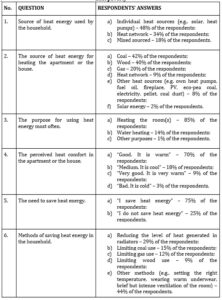
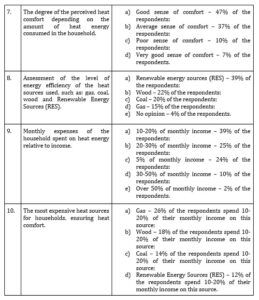
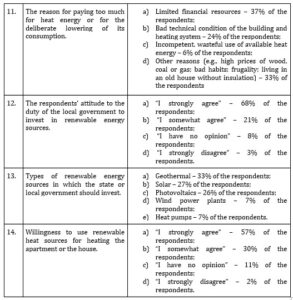
The conducted research analysis demonstrates that the factors with the most significant impact on the level of heat energy poverty among households include energy prices that are often disproportionate relative to the household income and are mainly influenced by economic, climatic, ecological, technical and technological factors, as well as the awareness of energy users. Other factors that contribute to heat energy poverty are the bad technical condition of buildings and their poor energy efficiency (heating efficiency), the total area of the apartment/house, climate and environment, as well as habits and preferences of the household dwellers. It should be noted that these causes are common between all European households experiencing heat poverty (Rau, Moran et al., 2020; Satish and Brennan, 2019; Castano-Rosa, Sherriff, Thomson, Guzman and Marrero, 2019; DellaValle, 2019; Domalewska, 2021; Jessel, Sawyer and Hernandez, 2019).
The consequences of heat poverty can be severe, and can be experienced in various areas, including, in particular: the decline in physical health (especially among children, the elderly and the chronically ill); experiencing cold inside the apartment/house of a varying degree; dampness and mold inside the apartment/house, which can lead to respiratory problems (e.g. asthma, bronchitis); a decline in the mental health (experienced anxiety or fear); social exclusion (weakening of neighborly and family relationships) that can, in turn, lead to low self-esteem and isolation; the dilapidation of buildings caused by low temperature; dampness inside; and improper insulation of windows, walls and doors, that lead to an increased heat loss. The consequences of heat poverty also include energy arrears with the heat suppliers, as well as low energy efficiency (lack of proper insulation) of buildings that lose heat, thus forcing increased consumption of heat energy from the installation, which generates higher energy costs, or outdated and inefficient heat installations (heat systems) and boilers, the owners of which cannot afford to replace them with new ones. A major consequence of heat poverty is also low-stack emissions, caused by the use of low-quality heat sources. Their impact on the air, soil and water is currently a considerable problem in both the domestic, European Union and the global politics (Świerszcz, 2020; Ucal and Xydis, 2020; Osano, Maghanga et al., 2020; Jessel, Sawyer and Hernandez, 2019).
Actions taken by the Local Government Unit in terms of the sustainable management of the local heat energy security in the Wiśniowa commune
The questionnaire survey conducted in the Wiśniowa commune shows that those responsible for the organization and management of the energy sector are aware of the phenomenon of heat energy poverty within the commune and are concerned about it. Based on the applied criterion of exceeding 10% of the household expenses for heat energy relative to all expenses, the phenomenon was observed in 10-30% of all households, and was most common among the elderly, large families and people living in old buildings (see Figure 2).
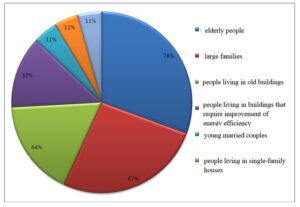
Fig. 2. Groups of households most often affected by heat energy poverty
Figure 3 presents the most common forms of aid provided for households by public and
non-public institutions. The annual amount of aid reaches PLN 0.1-1 million.
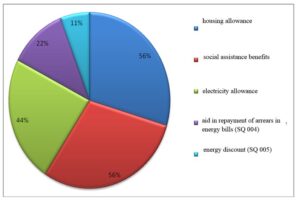
Fig. 3. Forms of aid provided for households by public and non-public institutions.
Over the recent years (2007 to 2019), the commune of Wiśniowa did not undertake any major investments aimed at increasing energy efficiency, due to the lack of sufficient funds. Such actions were undertaken only in 33% of the cases, and their scope is shown in Figure 4.
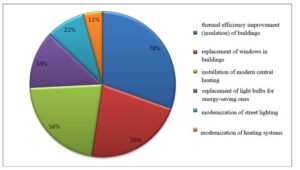
Fig. 4. The scope of actions taken by the Local Government Unit in terms of increasing energy efficiency
The financial resources allocated for the above-mentioned initiatives to help reduce energy poverty among inhabitants and improve their quality of life in terms of heating households, ranged from PLN 1 to 5 million. Their effectiveness ranged between 10-20%, mainly in terms of lowering the consumption of heat energy by approximately 30-40%. The achieved level of satisfaction with the effects of the actions taken by the local authorities among the inhabitants of the commune was good (ranging between 80-90%).
Due to the generally high consumption of heat energy by households and the associated high financial costs, the Local Government Unit of the Wiśniowa Commune would be very willing to invest in geothermal energy. Heat energy generated in such a way would be an alternative solution that would help reduce costs. This type of energy would be primarily used for: a geothermal heating plant that is planned to be built, a district heating network, heating buildings, pavements, for the school’s sports ground, as well as for recreational and therapeutic purposes, and to encourage tourism as well. Currently, the commune of Wiśniowa is considering the use of geothermal resources that were discovered there in the 1990s (Świerszcz and Grenda, 2018a; Bendea, Popa and Georgescu, 2017). The argument in favor of investments in geothermal energy as part of the energy policy of the commune is due to its specific nature. Such energy could guarantee: the independence of energy costs from the prices of energy carriers; the independence of fossil fuel supplies; lower unit costs of obtaining geothermal heat energy compared to conventional heating plants; lower costs of geothermal energy compared to other fossil-based energy; and the inability to transport geothermal energy over long distances, which prevents the monopolization of such energy solutions. In addition to its economic advantages, other important advantages of geothermal resources include: their sustainability and renewability; prevalence; decentralization (i.e. obtaining energy from resources located in the vicinity of potential users), which allows for reducing losses related to the transmission of energy over long distances and the independence of small regions and local populations; the independence of climate and weather changes; and, last but not least, the eco-friendly nature of the energy – such resources do not contribute to the pollution of the natural environment (Świerszcz, 2020; Wojnarowska-Szpucha, 2020a).
In addition to investments in geothermal resources, the Local Government Unit also recommends additional, complementary tools to help solve the problem of heat poverty that include, in particular: revolving funds, subsidies from the European Union, the construction of energy-efficient municipal flats, the implementation of projects that connect flats (not only municipal) to the local heating network supplied with geothermal energy, improving the energy efficiency of buildings, and motivating companies from the energy-related sector to implement actions beneficial to recipients experiencing energy poverty (in return for receiving white ‘energy-efficiency’ certificates in a modified form).
The survey clearly shows that in the local policy of heat energy security management, the local government mentions the possibilities or even the need to reduce the demand for energy. The proposed forms of aid include an improvement in the energy efficiency of residential buildings for people with low incomes, investments in the modernization of street lighting or the thermal efficiency improvement of public buildings. However, the most effective undertaking aimed at counteracting energy poverty is the investment in the geothermal resources available within the territory of the commune. It should be emphasized that the inhabitants of the commune are also keenly interested in this solution of counteracting heat energy poverty. Taking this into consideration, the local government has commenced the implementation of this solution by drafting important documentation, including: Objectives of the Plan for the supply of heat, electricity and gas fuel in the commune of Wiśniowa; Low-emission economy plan for the commune of Wiśniowa until 2022; Environmental protection program for the commune of Wiśniowa for the years 2019–2022; The concept of a district heating network in Wiśniowa; Preliminary assessment of the possibility of extracting and using geothermal water in Wiśniowa and the surrounding regions; Analysis of the conditions for the use of geothermal resources extracted using the Wiśniowa GT-1 well; A study on the conditions and directions of spatial development in the commune of Wiśniowa and the Development strategy for the commune of Wiśniowa until 2025, including the search for new heat energy sources and ways to a reduce carbon dioxide emissions.
Results And Discussion
Although in the commune of Wiśniowa, the problem of energy poverty has already been acknowledged, similarly to other parts of Poland, it is still relatively little known, despite the fact that it is clearly experienced by many households. This phenomenon is based on the aforementioned three key factors: economic (relatively low household income and high energy costs), technical (poor energy efficiency of the household), and, last but not least, attitude-related (ineffective and wasteful use of the available energy).
The research results, in the form of responses to the questionnaire from the inhabitants of the commune, apart from their statistical value, provide general guidelines that should be summed up and treated as some kind of recommendations for future actions to be taken not only in the commune, but also at a national level. However, this does not diminish the need for the independent decision-making of the local authorities of the commune.
Actions that should be taken in the first place are recommended by the author as follows:
- Establishing an unambiguous, official definition of energy poverty for Poland, for the needs of offices at various levels – this task should be undertaken by academics dealing with the topic;
- Determining and starting to eliminate the causes of insufficient recognition of the scale of energy poverty in communes – this task requires cooperation between local governments and academics dealing with the topic;
- Motivating communes to research the current situation of energy poverty in their area – this task requires cooperation between local governments and academics dealing with the topic;
- Preparing a comprehensive study on the size and scale of energy poverty – this task should be undertaken by academics dealing with the topic;
- Organizing an informational and educational media campaign for communes as well as for fuel and energy consumers/users – this task should be undertaken by the media and non-governmental organizations, as well as academics dealing with the topic;
- Recognizing the fact that cash direct payments for fuel and energy are not the optimal form of aid, although temporarily, in a controlled form, they will be effective as ad hoc measures;
- Motivating companies from the energy sector and other entities to take effective actions with their customers (as part of CSR), e.g. by using a system of white (energy-efficiency) certificates modified for this purpose – this task should be undertaken by local governments.
- Investing in renewable energy sources, including geothermal energy, of which approximately 60-70% is available in Poland.
These actions at the local level can and should be undertaken as soon as possible. The accurate definition of the phenomenon and development of solutions to the problem should be included in the objectives of the plan for the supply of heat, electricity and gas fuel. These documents should be updated on a regular basis (at least every three years) to provide an opportunity for adding new problems to be resolved, as needed.
Conclusion
Heat energy poverty is a phenomenon commonly experienced by households and, at the same time, recognized by the Local Government Unit of the Wiśniowa Commune. This awareness, however, in terms of heat energy security – despite many effective actions taken – is insufficient, which is evidenced by both the results of the survey and by the declarations of the Commune officials.
In order to efficiently and effectively manage – in a sustainable manner – local heat energy security, and thus effectively counteract the phenomenon of heat energy poverty in households, qualified employees are required for Local Government Units, and they should be familiar with the above-mentioned problem. What is also needed is the cooperation with universities that deal with the implementation of energy efficiency projects; the cooperation with other communes in the powiat, then the voivodeship, and finally at the national level; as well as the financial aid from national and EU institutions for the implementation of sustainable energy efficiency projects, such as the Regional Operational Program (RPO), the National Fund for Environmental Protection and Water Management (NFOŚiGW), Clean Air (Czyste Powietrze) and other. A helping hand should also be extended by companies involved in sustainable energy efficiency projects and social care, to support, to the best of its financial capabilities, counteracting heat poverty among the inhabitants of the commune.
(adsbygoogle = window.adsbygoogle || []).push({});
References
- Bakirtas, T. and Gokce Akpolat, A. (2018) ‘The relationship between energy consumption, urbanization, and economic growth in new emerging-market countries,’ Energy, 147, 110-121.
- Blisko 3 mln Polaków nie stać na ogrzewanie. Czy zmieni to taryfa antysmogowa?, https://superbiz.se.pl/wiadomosci/blisko-3-mln-polakow-nie-stac-na-ogrzewanie-czy-pomoze-taryfa-antysmogowa-aa-Y9aH-NbnN-MU11.html
- Bordman, B. (2012) ‘Fuel poverty synthesis: Lessons learnt, actions needed,’ Energy Policy, 49, 143-148.
- Castano-Rosa, R., Sherriff, G., Thomson, H., Guzman, JS. and Marrero, M. (2019), ‘Transferring the index of vulnerable homes: Application at the local-scale in England to assess fuel poverty vulnerability,’ Energy And Buildings, 203, UNSP 109458, DOI: 10.1016/j.enbuild.2019.109458.
- Chukwuka, G., Monyei, Lukumon, O., Oyedele, Olugbenga, O., Akinade, Anuoluwapo, O., Ajayi, Absalom, E., Ezugwu, Kingsley, O., Akpeji, Serestina, Viriri, Aderemi O. Adewumi, Daniel Akinyele, Olubayo M., Babatunde, Michael, O., Obolo, J. and Onunwor, C., (2019) ‘An income-reflective scalable energy level transition system for low/middle income households,’ Sustainable Cities and Society, 45, 172-186, https://doi.org/10.1016/j.scs.2018.10.042.
- Cipriano, X., Gamboa, G., Danov, S., Mor, G. and Cipriano, J. (2017) ‘Developing indicators to improve energy action plans in municipalities: An accounting framework based on the fund-flow model,’ Sustainable Cities and Society, 32, 263-276, https://doi.org/10.1016/j.scs.2017.03.004.
- Dagoumas, A. (2014) ‘Modelling socio-economic and energy aspects of urban systems,’ Sustainable Cities and Society, 13, 192-206, https://doi.org/10.1016/j.scs.2013.11.003.
- Della, Valle, N. (2019) ‘People’s decisions matter: understanding and addressing energy poverty with behavioral economics,’ Energy And Buildings, 204, UNSP 109515, DOI: 10.1016/j.enbuild.2019.109515.
- Domalewska, D. (2021) ‘A Longitudinal Analysis of the Creation of Environmental Identity and Attitudes towards Energy Sustainability Using the Framework of Identity Theory and Big Data Analysis,’ Energies, 14(3):647. https://doi.org/10.3390/en14030647.
- Fan, Y. and Fang, Ch. (2020) ‘Insight into carbon emissions related to residential consumption in Tibetan Plateau–Case study of Qinghai,’ Sustainable Cities and Society, 61, 102310, https://doi.org/10.1016/j.scs.2020.102310.
- Fuel poverty statistics, (2013), [Online], [Retrieved August 12, 2019], www.gov.uk/government/collections/fuel-poverty-statistics.
- Gawlik-Kobylińska, M. (2018) ‘Reconciling ADDIE and Agile instructional design models—case study.’ New Trends and Issues Proceedings on Humanities and Social Sciences. [Online]. 5(3), 14-21. https://doi.org/10.18844/prosoc.v5i3.3906.
- Gawlik-Kobylińska, M. (2017) ‘Task-Based Approach in 3D Education for Security and Safety,’ International Journal on Information Technologies and Security, No. SP1 (vol. 9) 20, 3-12. (ISSN 1313-8251).
- Gouveia, J. P., Palma, P. and Simoes, S. G. (2019) ‘Energy poverty vulnerability index: A multidimensional tool to identify hotspots for local action,’ Energy Reports, 5, 187-201, DOI: 10.1016/j.egyr.2018.12.004.
- Horta, A., Gouveia, J. P., Schmidt, L., Sousa, J. C., Palma, P. and Simoes, S. (2019) ‘Energy poverty in Portugal: Combining vulnerability mapping with household interviews,’ Energy And Buildings, 203, UNSP 109423, DOI: 10.1016/j.enbuild.2019.109423.
- Jessel, S., Sawyer, S. and Hernandez, D. (2019) ‘Energy, Poverty, and Health in Climate Change: A Comprehensive Review of an Emerging Literature,’ Frontiers In Public Health, 7, 357, DOI: 10.3389/fpubh.2019.00357.
- Monyei, Ch. G., Oyedele, L. O., Akinade, O. O., Ajayi, A. O., Ezugwu, A. E., Akpeji, K. O., Viriri, S., Adewumi, A. O., Akinyele, D., Babatunde, O. M., Obolo, M.O. and Onunwor J. C. (2019) ‘An income-reflective scalable energy level transition system for low/middle income households,’ Sustainable Cities and Society, 45, 172-186, https://doi.org/10.1016/j.scs.2018.10.042.
- Muringathuparambil, R. J., Musango, J. K., Brent, A. C. and Currie, P. (2017) ‘Developing building typologies to examine energy efficiency in representative low cost buildings in Cape Town townships,’ Sustainable Cities and Society, 33, 1-17, https://doi.org/10.1016/j.scs.2017.05.011.
- Osano, A., Maghanga, J., Munyeza, C. F., Chaka, B., Olal, W. and Forbes P. B. C. (2020) ‘Insights into household fuel use in Kenyan communities,’ Sustainable Cities and Society, 55, 102039, https://doi.org/10.1016/j.scs.2020.102039.
- Owczarek, D. and Miazga, A. (2015) Ubóstwo energetyczne w Polsce – definicja i charakterystyka społeczna grupy, Instytut na rzecz ekorozwoju, Warszawa.
- Polityka energetyczna Polski do 2030 roku, Ministerstwo Gospodarki, Warszawa 2009.
- Projekt Polityki energetycznej Polski do 2050 roku, Ministerstwo Energii, (2014), Ministerstwo Energetyki, Warszawa.
- Rau, H., Moran, P., Manton R. and Goggins, J. (2020) ‘Changing energy cultures? Household energy use before and after a building energy efficiency retrofit,’ Sustainable Cities and Society, 54, 101983, https://doi.org/10.1016/j.scs.2019.101983.
- Rodrigues, L., Gillott, M., Waldron, J., Cameron, L., Tubelo, R., Shipman, R. and Ebbs, N. (2020) ‘Bradshaw-Smith Ch., User engagement in community energy schemes: A case study at the Trent Basin in Nottingham, UK,’ Sustainable Cities and Society, 61, 102187, https://doi.org/10.1016/j.scs.2020.102187.
- Satish, BK. and Brennan, J. (2019) ‘Understanding the energy use behaviour of British Indian households to shape optimised sustainable housing strategies in existing housing stock,’ Sustainable Cities and Society, 48, 101542, https://doi.org/10.1016/j.scs.2019.101542.
- Sharpe, RA., Machray, KE., Fleming, LE., Taylor, T., Henley, W., Chenore, T., Hutchcroft, I., Heaviside, C., Heaviside, C. and Wheeler, BW. (2019) ‘Household energy efficiency and health: Area-level analysis of hospital admissions in England,’ Environment International, 133, DOI: 10.1016/j.envint.2019.105164.
- Szpor, A. (2016) Ubóstwo energetyczne w Polsce – temat zastępczy czy realny problem?, IBS Policy, Warszawa.
- Szyłkowska, M. (2019a) ‘Safety and Security Criterion as The Primary of Future User-Supplier Relations (Research in Progress)’ Proceedings of the 34th International Business Information Management Association Conference (IBIMA).
- Szyłkowska, M. (2019b) ‘Security system creating in conditions of uncertainty and riskoutline of the problem,’ International Scientific Journal “Security & Future“. (ISSN:2535-0668).
- Świerszcz, K. (2016), Bezpieczeństwo energetyczne Polski – wybrane aspekty obronne, Energetyka – szanse, wyzwania i zagrożenia. Logistyka – ekonomia – prawo – polityka – bezpieczeństwo – obronność – technika, Fundacja na rzecz Czystej Energetyki, Poznań, 305-324. (ISBN 978-83-64541-10-0).
- Świerszcz, K. (2020), Heat poverty as a measure of local energy security, WAT, Warszawa. (ISBN 978-83-7938-251-4).
- Świerszcz, K. (2020), ‘Indicators and Measures of Thermal Energy Poverty in the Shaping of the National Energy Security Policy, Based on the Example of Poland’ Proceedings of the 35th International Business Information Management Association Conference (IBIMA), editor K. S. Soliman, Granada, Spain 1-2 April 2020, 9193-9210. (ISBN: 978-0-9998551-4-0).
- Świerszcz, K. (2019), Postrzeganie bezpieczeństwa energetycznego w kontekście przeciwdziałania ubóstwu energetycznemu społeczności lokalnej z wykorzystaniem zasobów geotermalnych na terenie Gminy Wiśniowa, WAT, Warszawa. (ISBN: 978-83-7938-217-0).
- Świerszcz, K. (2017a), ‘The Impact of Energy Poverty on the Level of Social Security,’ Proceedings of the 4th International Conference on Management Science and Management Innovation, Edited by Hui-Ming Wee, ATLANTIS PRESS, Suzhou, China, 175-178, (ISBN: 978-94-6252-369-2) (ISSN 2352-5428).
- Świerszcz, K. (2017b), Ubóstwo energetyczne w Polsce wyzwaniem dla niemilitarnego systemu bezpieczeństwa energetycznego społeczności lokalnych kraju, Europa i Unia Europejska w czasach kryzysu. Wybrane aspekty, Stelmach, A. and Skarżyński, M. (ed), WNPiD UAM, Poznań, 159-172. (ISBN 978-83-65817-04-4).
- Świerszcz, K. and Grenda, B. (2018a), ‘Geothermal Energy as an Alternative Source and a Countermeasure Against Low Emission in the Ecological Security Strategy’ Proceedings of the 2018 Joint International Conference on Energy, Ecology and Environment (ICEEE 2018) and International Conference on Electric and Intelligent Vehicles (ICEIV 2018), 1-6 (ISBN: 978-1-60595-590-2; ISSN: 2475-8833).
- Świerszcz, K., Grenda, B., Szczurek, T. and Chen, B. (2019), ‘The Importance of Geothermal Energy in Energy Security: Towards Counteracting Energy Poverty of Households’ Proceedings of the 33th International Business Information Management Association Conference (IBIMA), editor K. S. Soliman, Granada, Spain 10-11 April 2019, 771-781. ISBN: 978-0-9998551-2-6.
- Uca,l M. and Xydis, G. (2020) ‘Multidirectional Relationship between Energy Resources, Climate Changes and Sustainable Development: Technoeconomic Analysis,’ Sustainable Cities and Society, 60, 102210, https://doi.org/10.1016/j.scs.2020.102210.
- Wojnarowska-Szpucha, S. (2020a) ‘Defense Benefits One of The Forms of Compliance with The Common Obligation of Defense,’ International Business Information Management Association (IBIMA), Sewilla, Spain, 14078-14083.
- Wojnarowska-Szpucha, S. (2020b) ‘The Essence of Social Security Against the Background of National Security and Its Threats,’ International Business Information Management Association (IBIMA), Sewilla, Spain, 2836-2839.
- Yering, D. (2005), Energy Security and Markets, In: Energy and Security: Toward a New Foreign Policy Strategy, (eds.) Goldwyn, G.L. and Kalicki, J.H., Woodrow Wilson Center Press with Johns Hopkins University Press, Waszyngton.
- Yoon, H. and Sauri, D. (2019) ‘No more thirst, cold, or darkness! – Social movements, households, and the coproduction of knowledge on water and energy vulnerability in Barcelona, Spain,’ Energy Research & Social Science, 58, UNSP 101276, DOI: 10.1016/j.erss.2019.101276.
- Żakowska, M. and Domalewska, D. (2019) ‘Factors Determining Polish Parliamentarians’ Tweets on Migration: A Case Study of Poland,’ Czech Journal of Political Science. Politologický časopis, 3: 200-216. https://doi.org/10.5817/PC2019-3-200.








